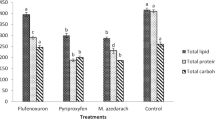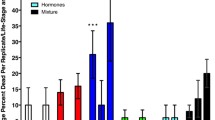Abstract
The navel orangeworm (Amyelois transitella) and the fungus Aspergillus flavus constitute a facultative mutualism and pest complex in tree nut and fruit orchards in California. The possibility exists that the broad detoxification capabilities of A. flavus benefit its insect associate by metabolizing toxicants, including hostplant phytochemicals and pesticides. We examined this hypothesis by conducting laboratory bioassays to assess growth rates and survivorship of pyrethroid-resistant (R347) and susceptible (CPQ) larval strains on potato dextrose agar diet containing almond meal with and without two furanocoumarins, xanthotoxin and bergapten, found in several hostplants, and with and without two insecticides, bifenthrin and spinetoram, used in almond and pistachio orchards. Additionally, fungi were incubated in liquid diets containing the test chemicals, and extracts of these diets were added to almond potato dextrose agar (PDA) diets and fed to larvae to evaluate the ability of the fungus to metabolize these chemicals. Larvae consuming furanocoumarin-containing diet experienced higher mortality than individuals on unamended diets, but adding A. flavus resulted in up to 61.7% greater survival. Aspergillus flavus in the diet increased development rate > two-fold when furanocoumarins were present, demonstrating fungal enhancement of diet quality. Adding extracts of liquid diets containing xanthotoxin and fungus decreased mortality compared to xanthotoxin alone. On diets containing bifenthrin and spinetoram, however, mortality increased. These results support the hypothesis that A. flavus enhances navel orangeworm performance and contributes to detoxification of xenobiotics. Among practical implications of our findings, this mutualistic association should be considered in designing chemical management strategies for these pests.




Similar content being viewed by others
References
(CDPR) California Department of Pesticide Regulation (2016) Pesticide use reporting. https://www.cdpr.ca.gov/docs/pur/pur16rep/16_pur.htm. Accessed August 2018
Alvarenga N, Birolli WG, Seleghim MHR, Porto ALM (2014) Biodegradation of methyl parathion by whole cells of marine-derived fungi Aspergillus sydowii and Penicillium decaturense. Chemosphere 117:47–52
Amaike S, Keller NP (2011) Aspergillus flavus. Annu Rev Phytopathol 49:107–133
Ampt EA, Bush DS, Siegel JP, Berenbaum MR (2015) Larval preference and performance of Amyelois transitella (navel orangeworm, Lepidoptera: Pyralidae) in relation to the fungus Aspergillus flavus. Environ Entomol 45:155–162
Bagchi VA, Siegel JP, Demkovich M, Zehr L, Berenbaum MR (2016) Impact of pesticide resistance on toxicity and tolerance of hostplant phytochemicals in Amyelois transitella (Lepidoptera: Pyralidae). J Insect Sci 16:1–7
Beck JJ (2013) Conopthorin from almond host plant and fungal spores and its ecological relation to navel orangeworm: a natural products chemist’s perspective. J Mex Chem Soc 57:69–72
Berenbaum MR (1991a) Coumarins. In: Rosenthal G, Berenbaum M (eds) Herbivores: their interactions with secondary plant Metabolites, vol 1. Academic Press, New York, pp 221–249
Berenbaum MR (1991b) Comparative processing of allelochemicals in the Papilionidae (Lepidoptera). Arch Insect Biochem Physiol 17:213–222
Bush DS, Lawrance A, Siegel JP, Berenbaum MR (2017) Orientation of navel orangeworm (Lepidoptera: Pyralidae) larvae and adults toward volatiles associated with almond hull split and Aspergillus flavus. Environ Entomol 46:602–608
Campbell BC, Molyneux RJ, Schatzki TF (2003) Current research on reducing pre-and post-harvest aflatoxin contamination of US almond, pistachio, and walnut. Toxin Rev 22:225–266
Ceja-Navarro JA, Vega FE, Karaoz HUZ, Jenkins S, Lim HC, Kosina P, Infante F, Northen TR, Brodie EL (2015) Gut microbiota mediate caffeine detoxification in the primary insect pest of coffee. Nat Commun 6:7618
Connell JH (2002) Leading edge of plant protection for almond. Hort Technol 12:619–622
Cotty PJ (1994) Influence of field application of an atoxigenic strain of Aspergillus flavus on the populations of A. flavus infecting cotton bolls and on aflatoxin content of cottonseed. Phytopathol 84:1270–1277
Cotty PJ, Bayman P (1993) Competitive exclusion of a toxigenic strain of Aspergillus flavus by an atoxigenic strain. Phytopathol 83:1283–1287
Curtis RK, Barnes MM (1977) Oviposition and development of the navel orangeworm in relation to almond maturation. J Econ Entomol 70:395–398
Demkovich M, Dana CE, Siegel JP, Berenbaum MR (2015a) Effect of piperonyl butoxide on the toxicity of four classes of insecticides to navel orangeworm (Amyelois transitella) (Lepidoptera: Pyralidae). J Econ Entomol 108:2753–2760
Demkovich M, Siegel JP, Higbee BS, Berenbaum MR (2015b) Mechanism of resistance acquisition and potential associated fitness costs in Amyelois transitella (Lepidoptera: Pyralidae) exposed to pyrethroid insecticides. Environ Entomol 44:855–863
Demkovich M, Siegel JP, Walse SS, Berenbaum MR (2018) Impact of agricultural adjuvants on the toxicity of the diamide insecticides chlorantraniliprole and flubendiamide on different life stages of the navel orangeworm (Amyelois transitella). J Pest Sci 91:1127–1136
Desjardins AE, Spencer GF, Plattner RD, Beremand MN (1989) Furanocoumarin phytoalexins, trichothecene toxins, and infection of Pastinaca sativa by Fusarium sporotrichioides. Mol Plant Pathol 79:170–175
Doster MA, Michailides TJ (1994) The development of early split pistachio nuts and their contamination by molds, aflatoxins, and insects. Acta Hortic 419:359–364
Finney GL, Brinkman D (1967) Rearing the navel orangeworm in the laboratory. 1. J Econ Entomol 60:1109–1111
Gilliam M, Prest DB, Morton HL (1974) Fungi isolated from honey bees, Apis mellifera, fed 2,4-D and antiobiotics. J Invertebr Pathol 21:213–217
Gilliam M, Prest DB, Lorenz BJ (1989) Microbiology of pollen and bee bread: taxonomy and enzymology of molds. Apidologie 20:53–68
Haviland DR, Symmes EJ, Adaskaveg JE, Duncan RA, Roncoroni JA, Gubler WD, Hanson B, Hembree KJ, Holtz BA, Stapleton JJ, Tollerup KE, Trouillas FP, Zalom FG (2017) UC IPM Pest Management Guidelines Almond. UC ANR Publication 3431. Oakland, CA
Kele RA, McCoy E (1971) Defined liquid minimal medium for Caryophanon latum. Appl Microbiol 22:728–729
Li X, Berenbaum MR, Schuler MA (2000) Molecular cloning and expression of CYP6B8: a xanthotoxin-inducible cytochrome P450 cDNA from Helicoverpa zea. Insect Biochem Mol Biol 30:75–84
Liang WQ, Wang ZY, Li H, Wu PC, Hu JM, Luo N, Cao LX, Liu YH (2005) Purification and characterization of a novel pyrethroid hydrolase from Aspergillus niger ZD11. J Agric Food Chem 53:7415–7420
Lund AE, Narahashi T (1983) Kinetics of sodium channel modification as the basis for the variation in the nerve membrane effects of pyrethroids and DDT analogs. Pestic Biochem Physiol 20:203–216
Luo Y, Gao W, Doster M, Michailides T (2009) Quantification of conidial density of Aspergillus flavus and A. parasiticus in soil from almond orchards using real-time PCR. J Appl Microbiol 106:1649–1660
Mao W, Berhow MA, Zangerl AR, McGovern J, Berenbaum MR (2006) Cytochrome P450-mediated metabolism of xanthotoxin by Papilio multicaudatus. J Chem Ecol 32:523–536
Mukherjee I, Mittal A (2005) Bioremediation of endosulfan using Aspergillus terreus and Cladosporium oxysporum. Bull Environ Contam Toxicol 75:1034–1040
Myung K, Manthey JA, Narciso JA (2008) Aspergillus niger metabolism of citrus furanocoumarin inhibitors of human cytochrome P450 3A4. Appl Microbiol Biotechnol 78:343–349
Nigg HN, Nordby HE, Beier RC, Dillman A, Macias C, Hansen RC (1993) Phototoxic coumarins in limes. Food Chem Toxicol 31:331–335
Niu G, Siegel J, Schuler MA, Berenbaum MR (2009) Comparative toxicity of mycotoxins to navel orangeworm (Amyelois transitella) and corn earworm (Helicoverpa zea). J Chem Ecol 35:951–957
Niu G, Rupasingh SG, Zangerl AR, Siegel JP, Schuler MA, Berenbaum MR (2011) A substrate-specific cytochrome P450 monooxygenase, CYP6AB11, from the polyphagous navel orangeworm (Amyelois transitella). Insect Biochem Mol Biol 41:244–253
Oliveira AP, Valentão P, Pereira JA, Silva BM, Tavares F, Andrad PB (2009) Ficus carica L.: metabolic and biological screening. Food Chem Toxicol 47:2841–2846
Palumbo JD, Mahoney NE, Light DM, Siegel J, Puckett RD, Michailides TJ (2014) Spread of Aspergillus flavus by navel orangeworm (Amyelois transitella) on almond. Plant Dis 98:1194–1199
Phillips D, Uota M, Monticelli D, Curtis C (1976) Colonization of almond by Aspergillus flavus. J Am Soc Hortic Sci 101:19–23
Ramadevi C, Nath MM, Prasad MG (2012) Mycodegradation of malathion by a soil fungal isolate, Aspergillus niger. Int J Basic Appl Chem Sci 2:108–115
Seyedmousavi S, Guillot J, Arné P, de Hoog GS, Mouton JW, Melchers WJG, Verweij PE (2015) Aspergillus and aspergilloses in wild and domestic animals: a global health concern with parallels to human disease. Med Mycol 53:765–797
Teng WY, Huang YL, Huang RL, Chung RS, Chen CC (2004) Biotransformation of imperatorin by Aspergillus flavus. J Nat Prod 67:1014–1017
USEPA (2017) Aspergillus flavus AF36; amendment to an exemption to a requirement of a tolerance. https://www.gpo.gov/fdsys/pkg/FR-2017-03-22/pdf/2017-05720.pdf
Waldbauer G, Cohen RW, Friedman S (1984) Self-selection of an optimal nutrient mix from defined diets by larvae of the corn earworm, Heliothis zea (Boddie). Physiol Zool 57:590–597
Watson GB (2001) Actions of insecticidal spinosyns on γ-aminobutyric acid responses from small-diameter cockroach neurons. Pestic Biochem Physiol 71:20–28
Widstrom N (1979) The role of insects and other plant pests in aflatoxin contamination of corn, cotton, and peanuts—a review. J Environ Qual 8:5–11
Acknowledgments
We thank Mark Demkovich for his advice and assistance. Daniel Raudabaugh advised us on mycology and experimental design, Dr. Rebecca Fuller advised us on graphing in R, and Dr. Themis Michailides provided the AF36 strain. This research was funded by the California Pistachio Research Board and the Almond Board of California. Mention of trade names or commercial products in this publication is solely for the purpose of providing specific information and does not imply recommendation or endorsement by the U.S. Department of Agriculture or the University of Illinois. USDA is an equal opportunity provider and employer.
Author information
Authors and Affiliations
Corresponding author
Rights and permissions
About this article
Cite this article
Bush, D.S., Siegel, J.P. & Berenbaum, M.R. Accelerated Development and Toxin Tolerance of the Navel Orangeworm Amyelois transitella (Lepidoptera: Pyralidae) in the Presence of Aspergillus flavus. J Chem Ecol 44, 1170–1177 (2018). https://doi.org/10.1007/s10886-018-1027-0
Received:
Revised:
Accepted:
Published:
Issue Date:
DOI: https://doi.org/10.1007/s10886-018-1027-0




